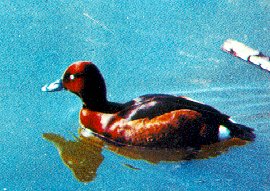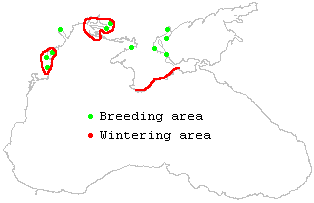 Synonyms:
Anas nyroca Guldenstadt, 1770 (1769)
Synonyms:
Anas nyroca Guldenstadt, 1770 (1769)Aythya nyroca Guldenstadt, 1770
 Synonyms:
Anas nyroca Guldenstadt, 1770 (1769)
Synonyms:
Anas nyroca Guldenstadt, 1770 (1769)
Common names: Engl: Ferruginous duck; Russ: Beloglazy nyroc; Turk: Karabas; Ukr: Bilooka chern'
Order: ANSERIFORMES
Family: ANATIDAE
Taxonomic descriptions:
 IUCN
Status:
IUCN
Status:
World level:
Black Sea Regional level:
Subregion level: VU
Distribution:
Habitats type, Critical habitats, Limiting factors: Breeding habitats are deep lakes, large lagoons, sandy spits with water-body covered with reeds and river estuaries.
Biology: The spring arrival of the first flock occurs at the end of February - in the first ten-day period of March. The mass passage is at the end of March. Breeding begins in May. The nest is situated on a broken reed. The clutch consists of 6-14 eggs, incubation is 25-28 days. In autumn the birds depart imperceptibly from the end of September till the end of October. Small groups of Ferruginous Ducks stay to winter in the region of the Danube and Black Sea Reserve and on the Southern coast of the Crimea. Mainly the birds eat vegetable food.
Population trends: About 2000 pairs are breeding in the Danube Reserve, 130-140 pairs in the Black Sea Reserve, 150 pairs in the Crimea, 10-15 pairs in Priazovie. In the Danube Reserve and Dnestr lagoon the number of species has decreased, on the lagoon of Azov-Black Sea region it is stable, in the northern Crimea it is slowly increasing.
Threats:
Conservation measures taken:
Conservation measures proposed: Creation of a protected areas network along the Azov coast and adding Stenzovsky Plavni to the Danube Reserve.
References:
Compiled by: P.Gorlov